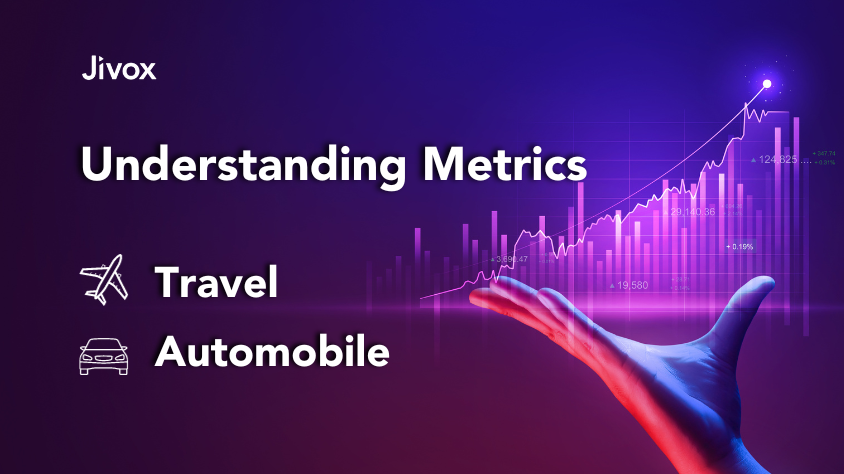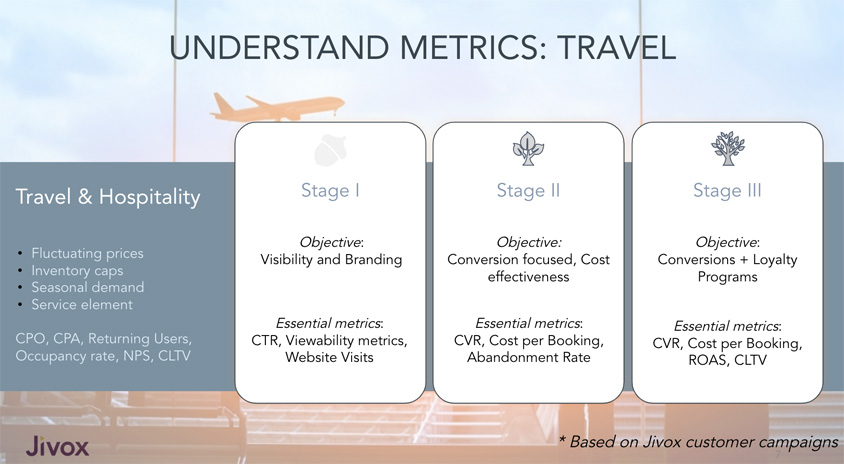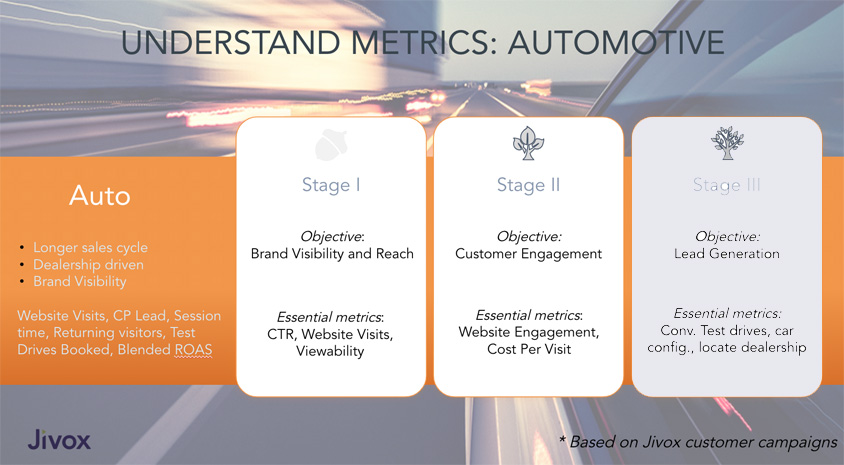The Travel & Automotive edition

As we mentioned in part 1 of the Mastering Metrics blogs, coming up with a key performance indicator (KPI) isn’t something any marketing team should take lightly. There we broke down the most effective KPIs for retail and CPG brands, but your specific industry is going to require specific KPIs. Just as you wouldn’t use a measuring cup to track distance, you shouldn’t use standard e-commerce metrics for your travel or automotive DCO campaigns.
Take me to:
Three Stages Of Marketing Personalization
We’ve defined three stages of personalization – Stage I, II and III. These stages are divided by how sophisticated a brand’s level of personalization is as well as the amount of data a brand has to work with. In stage I for example, brands will have just started personalizing ads to individual consumers while at stage III, they’ll have a robust customer journey that personalizes ads across channels and for different stages of the marketing funnel. For each of these three stages, your brand will have different KPIs that are industry specific.
We should note that none of the following metrics are set in stone. Some brands are unique in their industry and require a different set of a KPIs. This blog is meant to be a solid starting point for guiding your choice of KPIs.
Ask yourself these questions
At this stage, what are my marketing campaign’s objectives?
What KPIs are relevant for measuring success against these objectives?
By the end of this blog, you should have answers to the above questions with which you’ll be able to check the health of your personalization strategy effectively and how these KPIs are helping your brand grow their marketing ROI.
Mastering KPIs for Travel And Hospitality Industry

The travel and hospitality industry is similar to retail as they both have a lot of customer data at their disposal. However, the big difference between these two industries is that travel and hospitality features a range of advertising complexities. The prices are always in flux and the inventory is limited. Additionally, the business is very seasonal and there’s a service component beyond bookings and reservations.
That’s why travel and hospitality brands benefit a lot from DCO. They have more dynamic elements in their ads and communications, from time-bound price fluctuations and promotions to language and currency adjustments based on geolocation data. They require creative automation to produce these many ad variations and the ability to adjust ad elements quickly and ideally, with minimal manual intervention. Given the large amount of experimentation these brands perform on their ads, quick adjustments are even more critical.
For KPIs, brands we work with often use metrics like cost per booking or cost per passenger. There’s a lot of emphasis on returning users, customer lifetime value and as for measuring service, they use net promoter score.
Stage I:
At this stage, travel and hospitality brands have similar personalization efforts to those in the retail industry. They’re running prospecting and fairly simple retargeting campaigns. The prospecting campaigns may have a lot of dynamic elements such as: proximity to airports/stations, family compositions, themed communication of work vs leisure, budget estimated messaging, weather, time of day/day of week, etc.
Their main focus at this stage is to drive traffic to their website for the purpose of capturing more data and building brand awareness, while standing out in a very competitive crowded market.
This data will then be used to feed their retargeting campaigns. At this stage, these brands will likely be using promotional and seasonal offers to get consumers to return to their websites.
Essential KPIs: visibility (CTR) and branding (Video completion rate, viewability rate), brand recall and building, cost/impression, NPS.
Stage II:
In stage two, travel and hospitality brands are diving deeper into reducing cost per conversion and are deploying more sophisticated retargeting strategies. The primary goal of these retargeting campaigns is to re-engage potential customers who may be holding off on booking or considering options, with less ad spends while boosting conversions at the same time.
At this level of personalization, brands benefit a lot by using feeds to their maximum capability. Working with a DCO partner that helps them streamline workflow that bring together the several feeds is essential as these feeds will need to accurately reflect latest pricing, flight and hotel information, seasonal promotional offers and package details. Any latency here will reduce the relevancy to the consumer. Imagine clicking on an ad for a discount vacation in the Bahamas, only to find out that there’s no seats available for months.
Brands are also monitoring and comparing customer journeys across channels and in order to understand which channels are providing the best results in terms of engagement and conversions and which channels should be optimized. And with DCO, they’ll be able to assess which formats are performing better by channel for deeper optimization.
Essential KPIs: Conversion rate, cost per booking, passengers, abandonment rate, cost/site visit, site visit/click, site visit/engaged visit, cost/engaged visit, cost/conversion, average booking value.
Stage III:
This advanced stage of personalization is more customer focused for travel and hospitality brands. They’ll have established a full-funnel perspective, started using AI to make booking recommendations and are finessing an already streamlined workflow in their product feeds. They’ll be able to make adjustments to their campaigns to reflect promotions within minutes by making simple adjustments to their product and offer feeds.
But unlike other industries, travel and hospitality personalization doesn’t stop at conversions. Post-conversion is an extremely important stage where loyalty point programs and value-added services are introduced with the main goal to get customers to return and expand on customer loyalty. A lot of communications at this point are sent over email and personalization efforts will focus on their loyalty and membership program points as well as promotions.
The ultimate goal at this stage is to keep customers engaged with personalized ads such as “Hey, this is the number of points in your wallet and here’s how you can use them”. In a marketing world driven by first-party data, capitalizing on this customer loyalty data can be the ticket to sustained success.
Essential KPIs: ROAS, customer lifetime value, booking/engaged visits, number of returning users.
Mastering KPIs For Automotive Industry
The auto industry is down a whole different road to travel and retail brands so DCO strategies and KPIs need to reflect that. Sales cycles are a lot longer and conversions are mostly dealership-driven for a unique mix of national to local messaging. As a result, one of the most important areas of focus for automotive businesses is brand visibility.
Stage I:
Automotive brands have a similar first stage of personalization to travel and hospitality. They’re focused on building an audience for the sake of creating greater brand awareness, using prospecting campaigns to achieve these KPIs.

Essential metrics: Click/impressions, Impressions/USD, CTR, Website Visits.
Stage II:
This is where automotive brands differ from other industries. Generally they will have a much longer consideration phase due to the comparatively high price of vehicles vs other products. Therefore they really start to hone in on customer engagement and want KPIs that answer some important engagement-related questions such as: Are people really interested in buying this type of vehicle and do they intend to purchase directly from them as the manufacturer?
Automotive brands will look closely at how much time users are spending on their site. They’ll analyze bounce rates, how many web pages are browsed per site visit and the overall cost per visit.
Since their goal is to ultimately drive consumers to their dealerships, their personalization efforts will be very context-based to establish the highest relevance in communications. They’ll focus on location, weather, time of day and day of the week. Their messaging will vary a lot based on when (Time of day or day of week) consumers are being exposed to their ads. They also want to make sure they’re reaching out to customers with the most relevant information possible, such as dealership location and hours of operation.
Essential metrics: Website visits, Bounce rates, Engaged visits, Cost/visit, Session time.
Stage III:
Brands at this stage will focus heavily on lead generation and prospecting. Leads are assessed very closely in order to get answers to key questions such as:
- Are these customers looking for test drives?
- Are people going to the dealership after configuring and experimenting with features for their own car on the brand website?
- Are they downloading sales collateral such as brochures for more in-depth information?
- Are they locating the dealership easily?
Personalization efforts will focus on sequential messaging in order to avoid repetition. They don’t want to show consumers the same features over and over again. Brands need to show different features and auto-optimize creatives showcasing these features based on their performance, while also focusing on consistent communication across all channels and touchpoints throughout the customer journey.
The messaging is also focussed on specific promotional information such as which specific cars are on sale in which dealership location. The KPIs will have to address how effective all of these efforts are.
Essential metrics: Test drives booked, Returning customers, RoAS, Converted Test drives, number of cars configured, number of located dealerships, brochure downloads.
Next Steps: Monitor & Optimize Effectively
With your key metrics in mind, the next step to successful DCO campaigns is to monitor and optimize these metrics effectively.
Here’s a preview of how Jivox IQ Blaze can help you monitor DCO KPIs with ease:
Instant Insights On Creative Performance
See your best performing creatives instantly with built-in previews that take into account real-time campaign data.
Share You Performance And Insights Effortlessly
Build custom Liveboards that highlight your key metrics and share visualizations with one click.
Find Your Metric Now
Instantly search for the metrics you need using an AI-powered natural language query. No more fumbling through charts and tables.
Contact us. Let us help you come up with the most effective KPI scorecard to drive your performance goals.